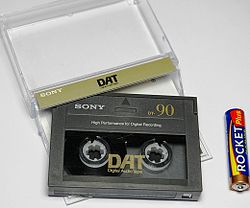
Back شريط الصوت الرقمي Arabic DAT Bulgarian DAT Catalan Digital Audio Tape Czech Digital Audio Tape German Cinta de audio digital Spanish DAT-nauha Finnish Digital Audio Tape French Digital Audio Tape Italian DAT Japanese
This article has multiple issues. Please help improve it or discuss these issues on the talk page. (Learn how and when to remove these template messages)
|
 | |
 A 90-minute DAT cartridge, with a AAA battery (LR03) for size comparison | |
| Media type | Magnetic cassette tape |
|---|---|
| Encoding | Lossless real-time |
| Capacity | Up to 120 or 180 minutes (consumer tapes on non-LP mode) |
| Read mechanism | Rotating head, helical scan |
| Write mechanism | Rotating head, helical scan |
| Developed by | Sony |
| Usage | Audio storage |
| Extended to | Digital Data Storage |
| Released | 1987 |
Digital Audio Tape (DAT or R-DAT) is a signal recording and playback medium developed by Sony and introduced in 1987.[1] In appearance it is similar to a Compact Cassette, using 3.81 mm / 0.15" (commonly referred to as 4 mm) magnetic tape enclosed in a protective shell, but is roughly half the size at 73 mm × 54 mm × 10.5 mm. The recording is digital rather than analog. DAT can record at sampling rates equal to, as well as higher and lower than a CD (44.1, 48, or 32 kHz sampling rate respectively) at 16 bits quantization. If a comparable digital source is copied without returning to the analogue domain, then the DAT will produce an exact clone, unlike other digital media such as Digital Compact Cassette or non-Hi-MD MiniDisc, both of which use a lossy data-reduction system.
Like most formats of videocassette, a DAT cassette may only be recorded and played in one direction, unlike an analog compact audio cassette, although many DAT recorders had the capability to record program numbers and IDs, which can be used to select an individual track like on a CD player.
Although intended as a replacement for analog audio compact cassettes, the format was never widely adopted by consumers because of its expense, as well as concerns from the music industry about unauthorized high-quality copies. The format saw moderate success in professional markets and as a computer storage medium, which was developed into the Digital Data Storage format. As Sony has ceased production of new recorders, it will become more difficult to play archived recordings in this format unless they are copied to other formats or hard drives. Meanwhile, the phenomenon of sticky-shed syndrome has been noted by some engineers involved in re-mastering archival recordings on DAT, which presents a further threat to audio held exclusively in this medium.
- ^ "Sony History". Sony.net. Archived from the original on 25 June 2010. Retrieved 19 September 2009.